*This post may contain affiliate links. Read more »
This msemen recipe is insanely flakey and buttery, which is an absolute shocker because (spoiler alert) it's completely vegan too. But don't make that turn you off. There's a reason why hundreds of recipe testers from around the world think this is the absolute best rghaif they have ever messed with!


Enter your email & I'll send it to your inbox. Plus, get great new recipes from me every week!
By submitting this form, you consent to receive emails from Cinnamon Snail.
Msemen is hot, crispy, and eternally the perfect palette for all your favorite Moroccan and Middle Eastern dishes to be carried to your mouth. Try it with Moroccan stewed white beans (Loubia), or the traditional Moroccan Ramadan fast-breaker Harira. I promise you will crave it all year round, because it’s seriously nourishing.
Grab a rolling pin and be transported to realms of perfect layered dough. Cosmic mysteries unravel, and the taste of magic lingers upon your tongue, forever transforming your stovetop bread game.
Jump to:
🙋♂️What is Msemen?
Msemen, also known as rghaif are square, flaky, laminated pancakes. Lamination, is the same process used in croissants, and puff pastry dough, of layering dough with fat to create tiny thin flakes in bread or pastry.
This delectable, square-shaped, laminated bread has transcended borders, captivating not only the hearts of Moroccans but also Tunisians and Algerians. Throughout history, msemen has remained a cherished breakfast and tea time delight, weaving its way into the cultural fabric of these North African nations.
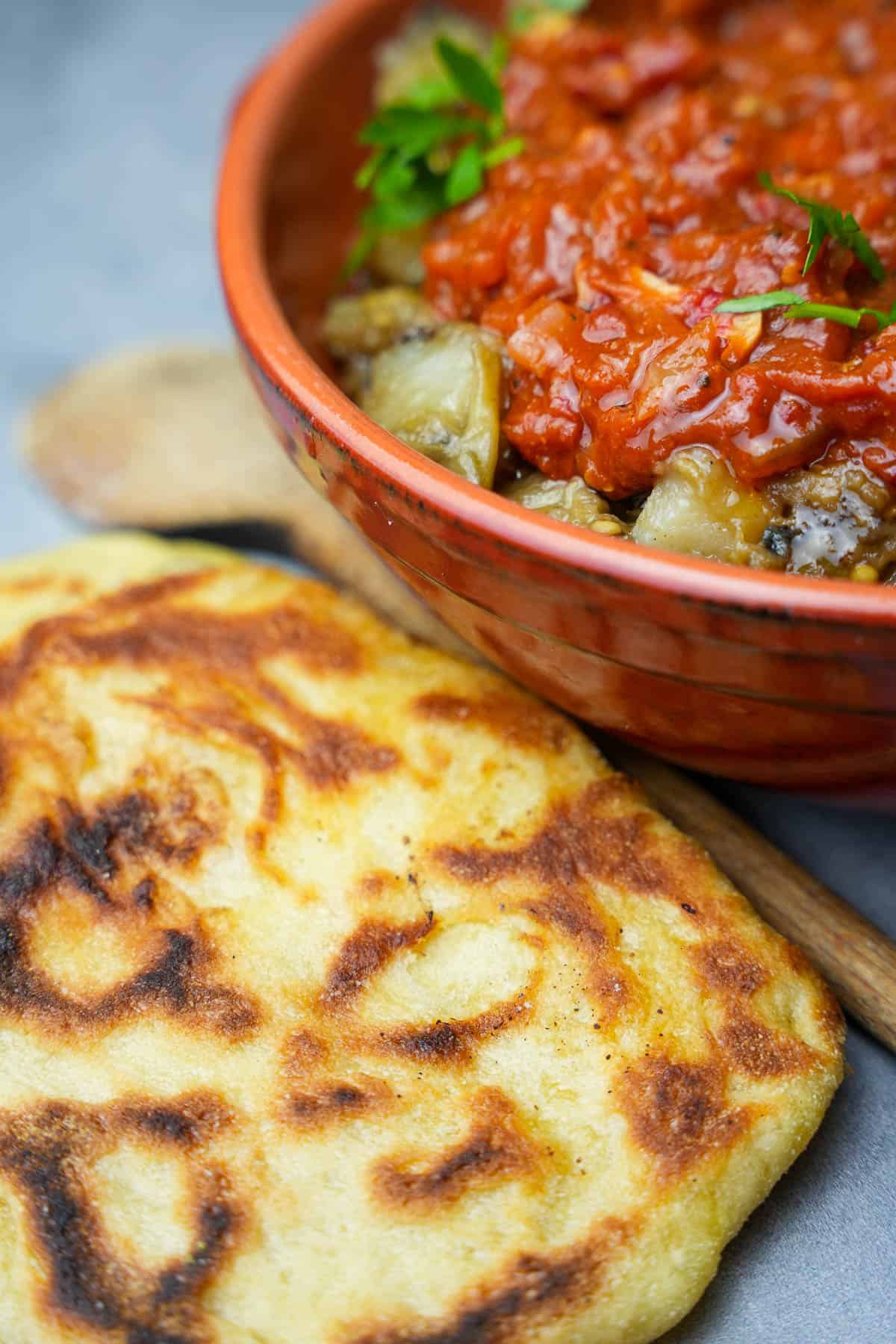


🤘Learn to make killer vegan Middle Eastern food
This guide to my most popular plant-based Middle Eastern recipes is 100% FREE, & you'll love the actual heck out of it 🥰
🥰Why you'll adore this msemen recipe
✊Vegan AF: Not only is this Msemen one of the flakiest, best-performing recipes you will find, but this one also happens to be of of the best vegan Middle Eastern recipes you've ever made.
🙅♂️🔥 Perfect bread without an oven: Imagine relishing homemade bread without heating your entire house! This recipe liberates you from the constraints of using an oven, making it an ideal option for hot summer days, and also making fresh homemade bread possible for folks who don’t have an oven.
✅ Super-well tested: all of the vegan recipe I share on this blog have first been put through the paces by a team of hundreds of recipe testers from around the world.
🧈 Msemen ingredients
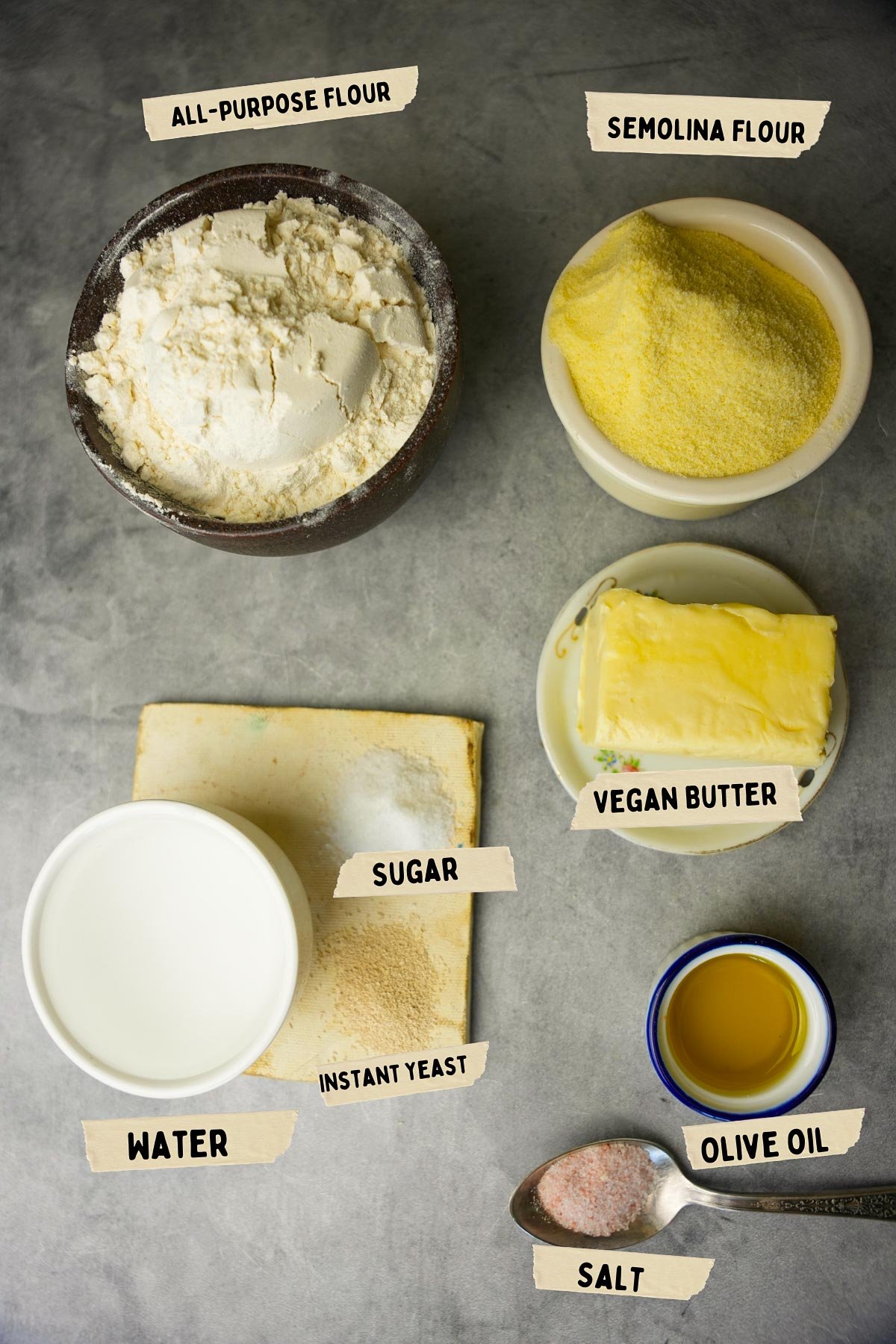
Semolina
Fine semolina flour, known as "Smida" in Moroccan cuisine, adds a unique texture and more complex flavor to breads like Msemen. If you don't have semolina flour on hand, you can substitute it with fine-grade corn flour (not as fine as masa harina though). The texture will be slightly different, but the bread will still work and be delicious. You can also make Irmik Helvasi, a Turkish sweet with pine nuts and sweet syrup.
Vegan Butter
Vegan butter is essential for creating the layered flakey texture in this recipe. For a vegan alternative, you can use refined coconut oil with a tiny pinch of salt mixed into it, which will provide a similar buttery flavor, and help to achieve the same texture. The preserved butter is traditionally used for making Msemen in Morocco is called “Smen”, and vegan butter does a great job in its place.
Yeast
Instant yeast transforms the dough into fluffy, airy perfection. It's my go-to yeast for making donuts and apple fritters, because it is quite forgiving and harder to over-ferment. If you don't have instant yeast, you can use active dry yeast (which I use for making kulcha bread) as a substitute, but activate it in warm water before adding it to the recipe.
There is a traditional yeast in Moroccan cooking called Khmira Beldia, which you can use in this recipe. But I wrote the recipe with instant yeast because it is readily available worldwide.

Some people use baking powder in place of yeast or leave out the leavening entirely. But after considerable testing, I am convinced the best msemen is made with a small amount of instant yeast in the dough. If you want to try a similar recipe that doesn’t use yeast, you should check out my recipe for Kerala-style parotta from south India.
*See the recipe card at the bottom of the page for exact quantities, nutritional info, and detailed cooking directions.
📖 How to make msemen
I’m going to walk you through the whole process of making perfect Msemen! Or you can follow along with the easy-to-print recipe card towards the bottom of this page.
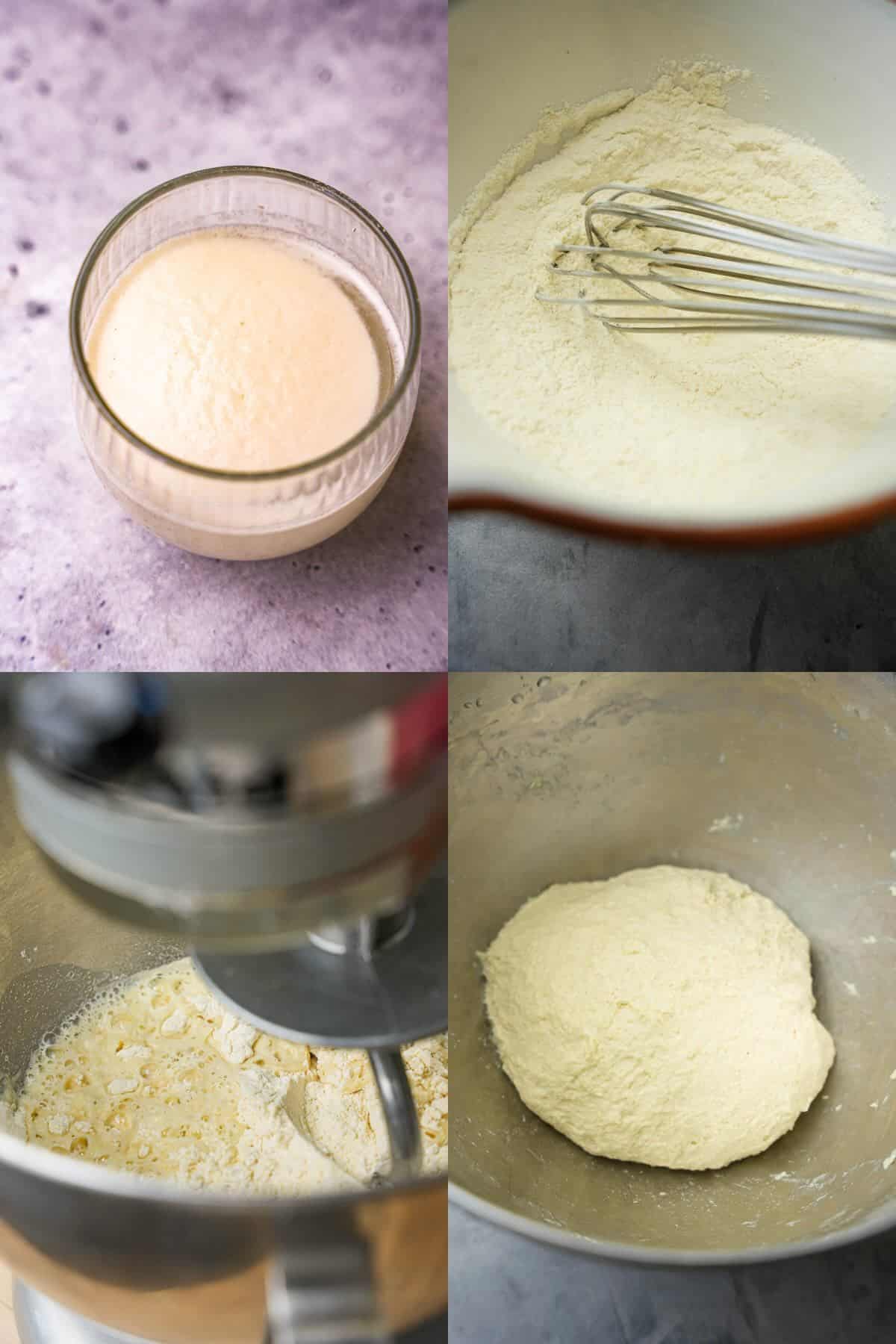
Step 1
In a small bowl, combine water, sugar, and instant yeast. Stir until yeast and sugar dissolve. Let it sit for 5 minutes until frothy.
Step 2
Combine the all-purpose flour, semolina flour, and salt in a large mixing bowl or stand mixer.
Step 3
Pour the yeast mixture into the dry ingredients. Mix until a sticky dough forms. If kneading by hand, transfer the dough onto a lightly floured surface. Knead for 5-7 minutes until smooth and elastic. Add more all-purpose flour if the dough is too sticky. If using a mixer, mix with the dough hook attachment for 4 minutes on low speed.
Step 4
The resulting dough should be tacky and a little bit wet feeling.

Step 5
Shape the dough into a ball and cover with a clean kitchen towel. Let it rest for sixty minutes to rise and become more pliable.
Step 6
Divide the dough into small golf ball-sized pieces. Each one should use less than ¼ cup of dough.
Flatten one piece of dough with your hands. Use a lightly oiled rolling pin to roll it into a thin, rectangular shape on an oiled work surface.
Step 7
Distribute small dollops of room-temperature vegan butter evenly on the dough. Sprinkle liberally with semolina flour.
Step 8
Fold the dough into thirds, like folding a letter.
Rotate 90 degrees and roll out again into a thin rectangle.

Step 9
Add a second dolloping of vegan butter and sprinkle of semolina, and then fold the dough over again, forming a neat, thick square or rectangle package.
Step 10
Repeat the laminating process with all dough balls.
Step 11
Brush the surface of the rolled-out dough with olive oil and gently roll it into a wider, thinner square, about five inches (12.5 cm.) on each side.
Step 12
Heat a non-stick skillet or griddle over medium heat.
Place the folded msemen onto the heated skillet and cook for a few minutes on each side until golden brown and cooked through.
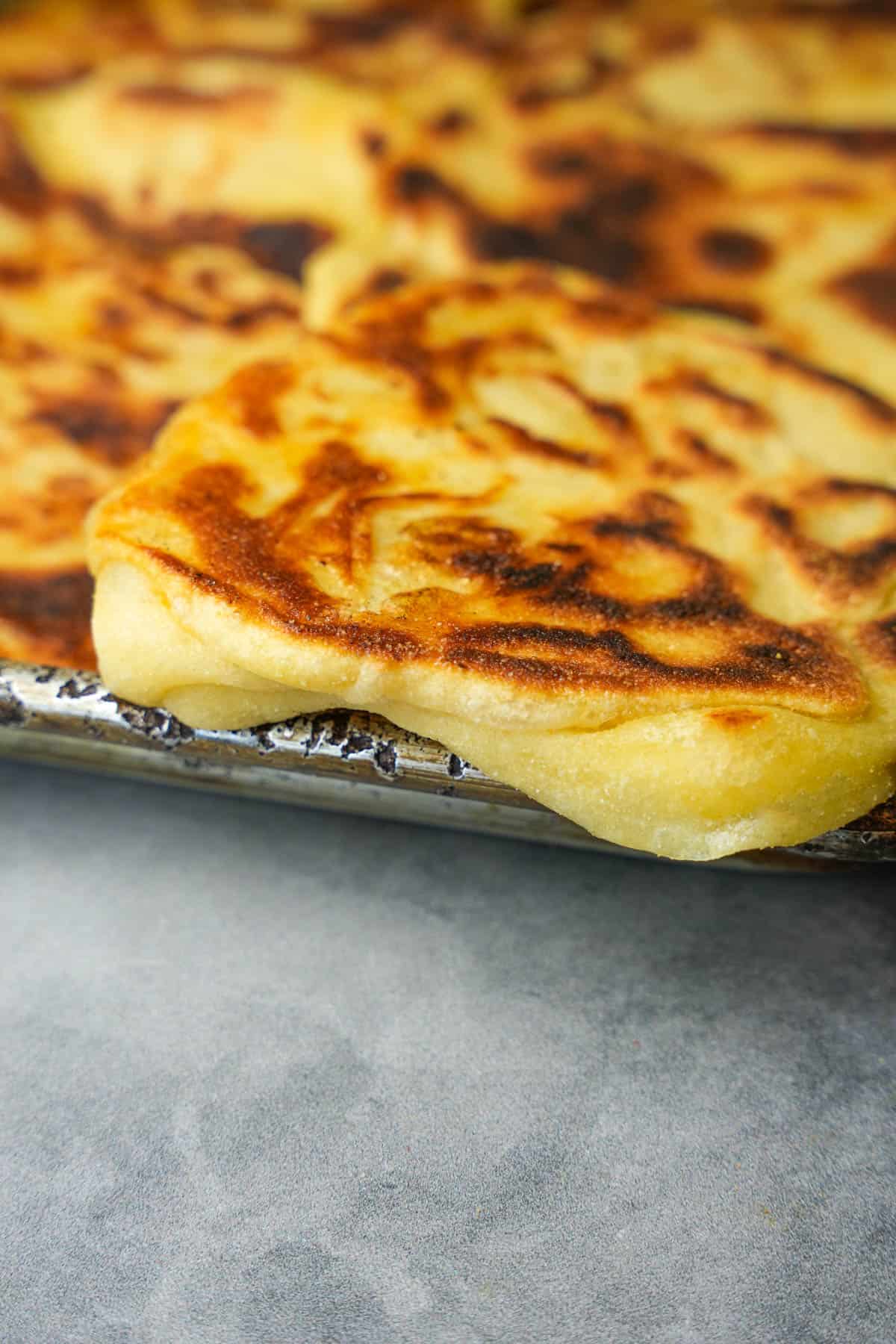
Step 13
Remove the cooked msemen from the skillet and place them on a plate lined with paper towels to absorb any excess oil.
Serve hot with all of your favorite things in life such as my cultured vegan cream cheese. Don’t know what to serve it with? Here are a ton of ideas, to get you really psyched to cook:
🍽️Serving Ideas
The simplest way to enjoy rghaif is to serve it at tea time either drizzled with warm syrup with vegan butter (messy, but super-good), or spread with vegan cream cheese frosting (or this killer homemade labneh) and your favorite jam or preserve (my personal faves are fig jam or grapefruit preserves). They are also irresistible served hot with my vegan Nutella.
Here are some legendary meals you can make Msemen the center of:
Serve rghaif as an accompaniment to Turkish classics like cig kofte, Mercimek köfte, bulgar pilavi.
Instead of kuboos (Arabic pita bread), you can serve classics like vegan kofta, or oyster mushroom shawarma dripping with Lebanese tarator (tahini dressing) on flaky layered msemen, to make the dishes even more rich. Serve it alongside a bowl of taboule, packed with tons of fresh herbs, and serve rosewater pistachio baklava for dessert.
Indian: That’s right bucko, rghaif is THAT versatile. Honestly, it is so similar to (shhh… don’t tell anyone I said BETTER) than Malabar Paratha. This makes rghaif an amazing bread to serve alongside toor dal tadka, curried ridge gourd, quick Indian fried okra, my easy-to-make red lentil dahl, or a giant bowl of veg. biryani topped with (get ready to hear, and then immediately make this…) VEGAN butter chicken!

What does msemen NOT go with?
Animal products. Real talk, it’s the 21st century. We can eat delicious food without causing violence to animals who are sentient beings and like us, deserve to be happy and free and not on a dinner plate. Be at peace, knowing you are not contributing to the violence in this world. Let’s make this planet a more harmonious place!
🥞Making msemen dough in advance
One way to achieve even more complex flavor while getting prep out of the way ahead of time is to store the dough rather than the cooked rghaif. Once the dough is mixed, transfer it to a lightly oiled storage container, and allow it to slowly ferment under refrigeration for up to 36 hours.

When you are ready to serve the msemen, remove the dough from the refrigerator and allow it to warm up for 40 minutes. Then form it and cook it in the pan according to my laminating instructions. This storage option makes the msemen even better!
👉Top tip
Here’s a little hack for easily using sticks of vegan butter:
To make the small dollops, you can dice the butter into small ½-centimeter cubes while it is still cold so that you can use the pre-portioned little bits of butter to easily use in the dough lamination.
If your vegan butter is unsalted, just sprinkle a tiny amount of salt between the layers when you are adding the semolina, to maintain the classic salted buttery flavor. While this CAN be made with unsalted butter, I think it tastes better using if salt is added between the layers.
🤷♀️Recipe FAQs
Msemen is pronounced as mehs-mehn. Rghaif is a synonym and is pronounced ruh-gah-eef Both words in Moroccan Arabic refer to the traditional square-shaped, flaky pancakes that are commonly enjoyed in Moroccan cuisine.
Both the wheat flour and fine semolina used to make msemen contain gluten. The gluten is essential in creating this classic Moroccan pancake's flaky, aerated texture.
🔥Stovetop Reheating:
To reheat msemen on the stovetop, preheat a non-stick skillet or griddle over low to medium heat. Place the desired amount of msemen onto the heated surface and warm them for a few minutes on each side until they are heated through. Be careful not to overheat or burn them. Once reheated, serve the msemen warm.
🥵Oven Reheating:
To reheat these Moroccan pancakes in the oven, preheat your oven to 350°F (175°C). Place the msemen on a baking sheet and cover them with aluminum foil to prevent them from drying out. Bake for five to ten minutes, or until heated through. Keep an eye on them to avoid overcooking. Once reheated, remove from the oven and serve warm.
✌️My faves to serve with msemen:
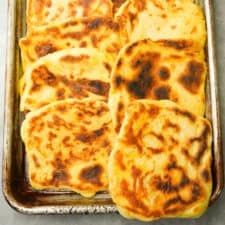
Msemen (flaky vegan Moroccan rghaif pancakes)
Ingredients
- 1 cups water
- 1 teaspoon sugar
- ¼ teaspoon instant yeast
- 1 ¼ cup all-purpose flour
- ¾ cups semolina flour
- ½ teaspoon salt
- ⅓ cup vegan butter for laminating
- ¼ cup extra semolina flour for laminating
- ¼ cup olive oil for rolling
Instructions
- In a small bowl, combine water, sugar, and instant yeast. Stir until the yeast and sugar have dissolved. Let it sit for about five minutes until the mixture becomes frothy.
- Meanwhile, combine all-purpose flour, semolina flour, and salt in a large mixing bowl or a stand mixer. Mix well.
- Pour the yeast mixture into the dry ingredients. Mix everything together until a sticky dough forms. If kneading by hand, transfer the dough onto a clean, lightly floured surface. Knead the dough for five to seven minutes until it becomes smooth and elastic. If the dough feels too sticky, you can add a little more all-purpose flour. If kneading in a mixer, mix with the dough hook attachment for four minutes on low speed.
- Shape the dough into a ball and cover it with a clean kitchen towel. Let it rest for an hour to allow the dough to rest, rise, and become smoother and more pliable.
- Once the dough has rested, divide it into small pieces, each about the size of a golf ball.
- Take one piece of dough and flatten it with your hands. Using a lightly oiled rolling pin, roll it into a thin, rectangular shape on an oiled work surface.
- Place small ¼ teaspoon dollops of room temperature vegan butter evenly over the surface of the rolled-out dough. Sprinkle lightly with about 1 teaspoon of semolina flour.
- Starting from one end, fold the dough into thirds, similar to folding a letter.
- Rotate the folded dough 90 degrees and roll it out again into a thin rectangular shape.
- Dollop again with vegan butter, dust with semolina, and repeat folding to form a thicker square shape.
- Repeat steps 6-10 with the remaining portions of dough.
- Brush the surface of the rolled-out dough with olive oil, and gently roll it into a thinner, wider square, about 5 inches (12.5 cm) on each side.
- Heat a non-stick skillet or griddle over medium heat.
- Place the folded msemen onto the heated skillet and cook for a few minutes on each side until golden brown and cooked through.
- Remove the cooked msemen from the skillet and place it on a plate lined with paper towels to absorb any excess oil.
- Repeat the process with the remaining dough pieces, adding more oil to the skillet as needed.
Notes
- Patience Wins: Take your time with each step. From mixing the dough to folding and cooking, patience ensures you get the right texture and flavor.
- Oil Wisely: Use a light touch when oiling your hands and the dough. Too much oil can make your msemen greasy, so go easy on it.
- Fold Gently: When folding the dough, be gentle. Don't press too hard – you want to maintain those layers for that delightful crispy bite.
- Heat Control: Keep an eye on your pan's heat. Cooking msemen over medium heat helps prevent burning and ensures even cooking.

Enter your email & I'll send it to your inbox. Plus, get great new recipes from me every week!
By submitting this form, you consent to receive emails from Cinnamon Snail.

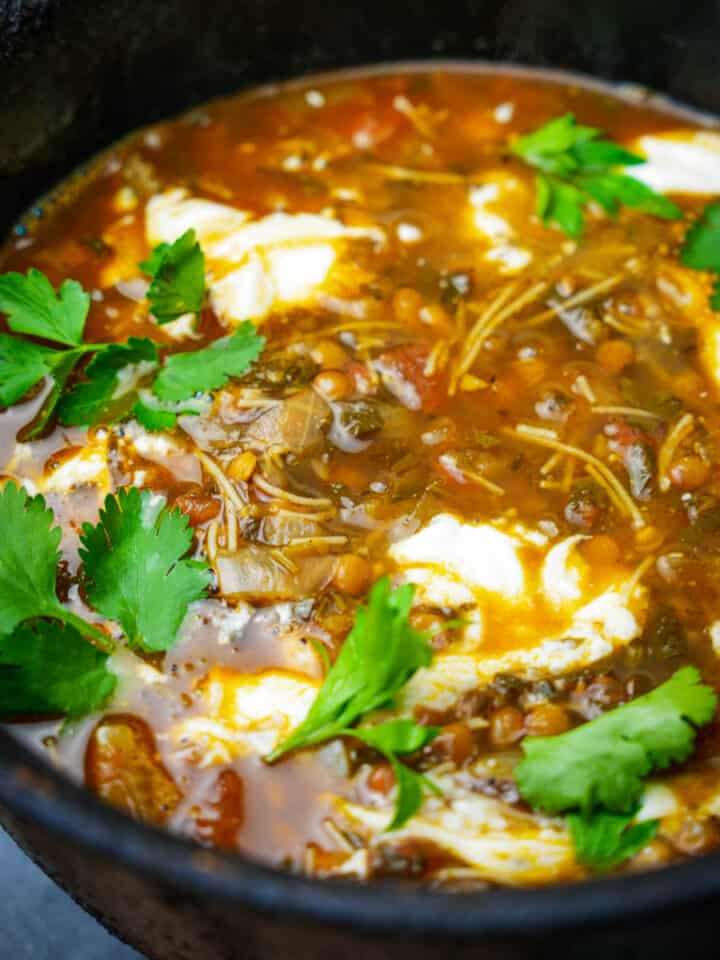
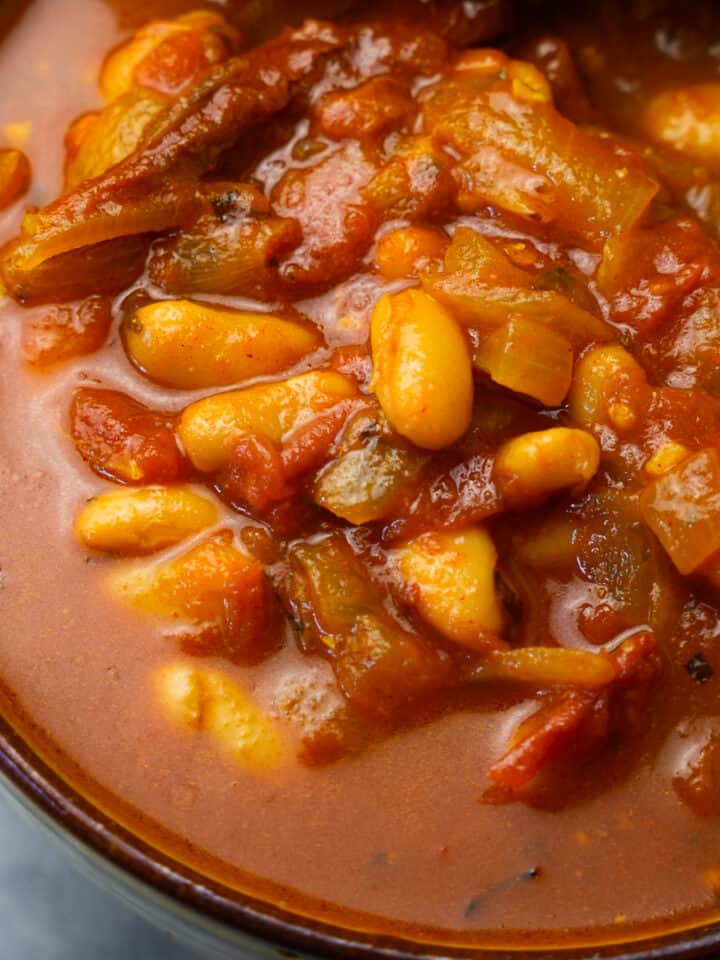
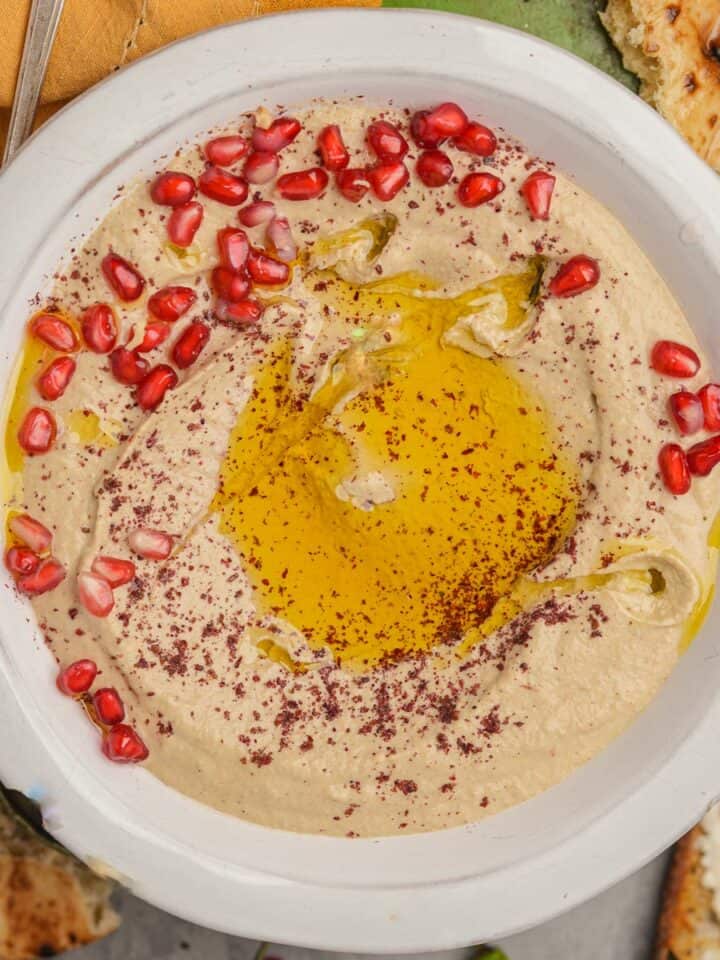







Cheryl says
So flaky and delicious! Used it as my scoop for the Labneh and Saksuka, sooo good!